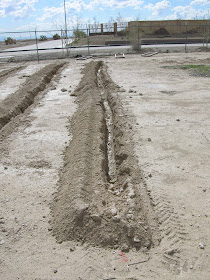Q. When can I put tomato
plants outside in the garden?
A. This has been a crazy Spring! Tomato plants grow best
when soils are warm and air temperatures are above 60° F and below 90°.
Traditionally, our last freeze is after mid-March. Most gardeners
like to get their tomato plants out earlier than this, any time after
mid-February, if its warm enough.
 |
| Tomato stem rot occurs on tomato plants frequently when soil temperatures are cold and tomatoes are put outside too early. |
Start watching weather projections, up to a few weeks
ahead, around mid-February. As soon as weather projections predict warm weather
for a 2 to 3 week period after mid-February, put transplants outside and help
them to adjust from the protected greenhouse to the harsher garden environment.
Put transplants in
a location protected from strong wind and intense afternoon sunlight. They
should get eight hours of sun every day to remain vigorous. Never plant them in
the same spot in the garden year after year. Plant them in a different part of
the garden each year to reduce disease problems.
Prepare the garden soil for planting while transplants
acclimate. Remember, tomatoes like warm soils so garden preparation should
focus on “fluffing” the soil so that it warms more quickly. Add compost to it
and double dig, spade or till the soil to open it and let warm air and sunlight
raise its temperature.
Heavy, wet soils warm slowly when temperatures are
rising. Alternatively, cover these spots with clear plastic, if you have to, to
trap heat and warm it more quickly. Pin the edges of the clear plastic to the
soil to keep the heat trapped under it.
When weather
projections are positive, plant tomatoes transplants into warm soil along with
a pre-plant fertilizer to improve rooting. If a generous application of compost
was used during garden preparation, then add only a phosphorus fertilizer to the
soil surrounding the transplant. This phosphorus fertilizer could be a mineral type
such as triple super phosphate or a natural phosphorus source like bone meal.









